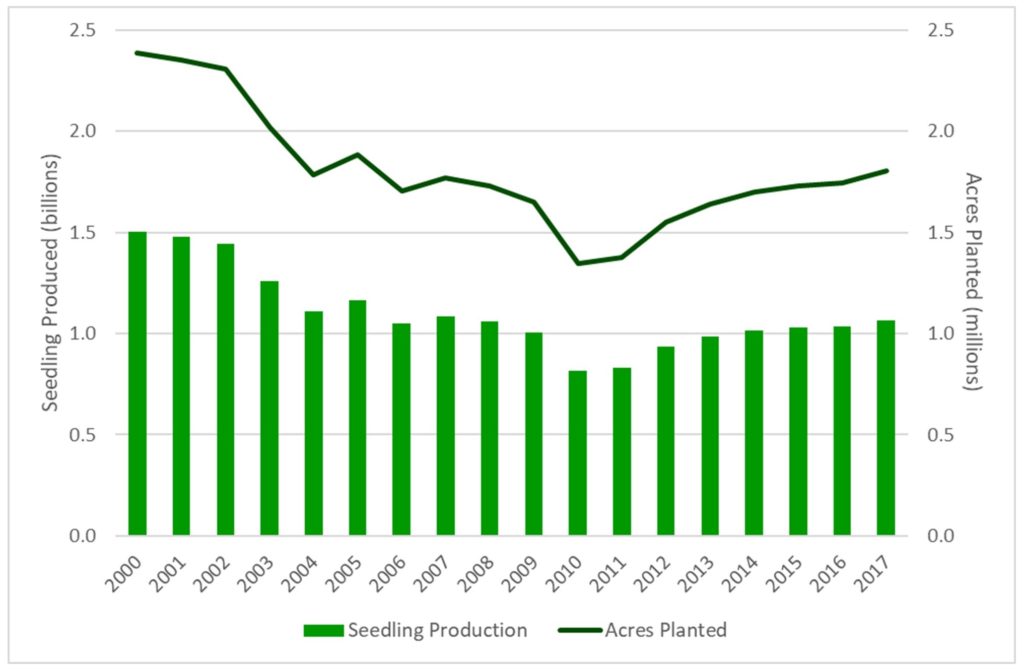There has been some concern in the forest industry that the slump in pine harvesting following the Great Recession – combined with excessive inventory accumulation and poor stumpage pricing – may have contributed to a severe decline in tree planting in recent years. A significant reduction in the availability of young plantations could directly affect wood supply for mills that rely on smaller-diameter stems.
Tree Planters’ Notes reports that seedling production by tree nurseries bottomed out in 2010 and has since recovered to pre-recession levels (Figure 1). Total production exceeded 1 billion seedlings for each of the past four years but still sits well below the peak of about 1.5 billion in 2000.

The assumptions we make regarding the density of trees planted per acre affect our estimate of the total acres planted with these seedlings. Multiple surveys of silvicultural practices in the South reveal that the average number of trees planted per acre has declined over the past two decades. In 2001, Forest Landowner reported an average planting density of 631 trees per acre, while the same study conducted in 2016 reported an average density of about 591 trees per acre (Note: This is higher than the planting density of 541 trees per acre reported by large, industrial pine plantation owners in our 2018 Silviculture Survey, but it provides a useful metric for the South as a whole, since their surveys include private, non-industrial landowners who own more than half of southern forests). We used a linear trend between these two data points to approximate the average planting density for each year. Using this method, we estimate that 1.8 million acres were planted in 2017 – the most since 2005, and up from just 1.34 million acres in 2010.
Despite the recovery in tree planting since 2010, the total number of planted pine acres in the South has stagnated. In 1980, the South had 19.3 million acres of planted pines, according to USFS FIA data (Figure 2). By 2000, that number had more than doubled to 39.0 million. In 2012, planted pine acreage peaked at 45.0 million acres and declined slightly to 44.5 million acres by 2014. Notably, this marks the first time that total pine plantation acres have declined southwide. Historically low prices for pine stumpage over the past several years are unlikely to encourage more conversions to planted pine, but robust tree planting activity in the past several years suggest that planted pine acres are likely to remain near all-time highs for the foreseeable future.

Sources:
Cost and Cost Trends for Forestry Practices in the South, 2001. Forest Landowner. M.R. Dubois, C. B. Erwin, and T. J. Straka.
Costs & Trends for Forestry Practices in the South, 2016. The Alabama Cooperative Extension System. Adam Haggard and Becky Barlow.
Forest Nursery Seedling Production in the United States—Fiscal Year 2017. George Hernández, Diane L. Haase, Carolyn Pike, Scott Enebak, Lori Mackey, Zhao Ma, and Mysha Clarke, in review.
Forest Nursery Seedling Production in the United States—Fiscal Year 2016. George Hernández, Diane L. Haase, Carolyn Pike, Scott Enebak, Lori Mackey, Zhao Ma and Mysha Clarke.
Forest Nursery Seedling Production in the United States—Fiscal Year 2015. George Hernández, Carolyn Pike, Diane L. Haase, Scott Enebak, Zhao Ma, Lysha Clarke and Lori Mackey.
Forest Nursery Seedling Production in the United States—Fiscal Year 2014. Diane L. Haase, George Hernández, Jennifer Lesko, Kea J. Woodruff, Richard A. Harper, Ronald P. Overton and Scott Enebak.
Forest Nursery Seedling Production in the United States—Fiscal Year 2013. Diane L. Haase, George Hernández, Justin Arseneault, Kea J. Woodruff, Richard A. Harper, Ronald P. Overton and Scott Enebak.
Tree Planting in the South, 1925 to 2012. George A. Hernández, Richard A. Harper, and David B. South.
USDA Forest Service, Forest Inventory and Analysis Program.

Leave a Reply